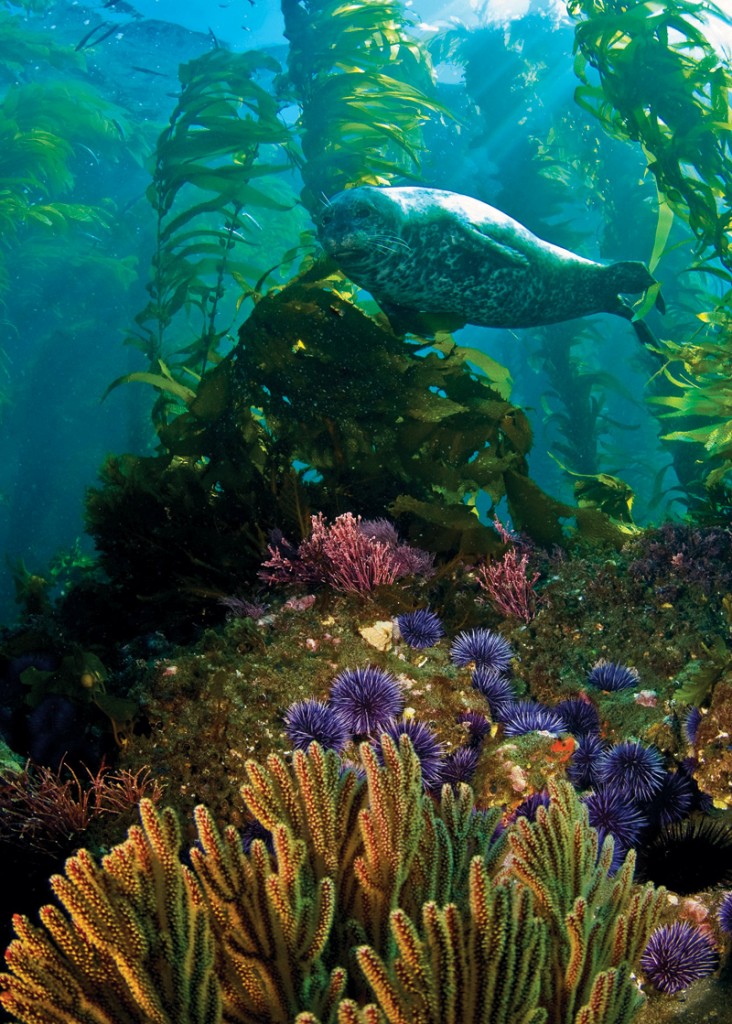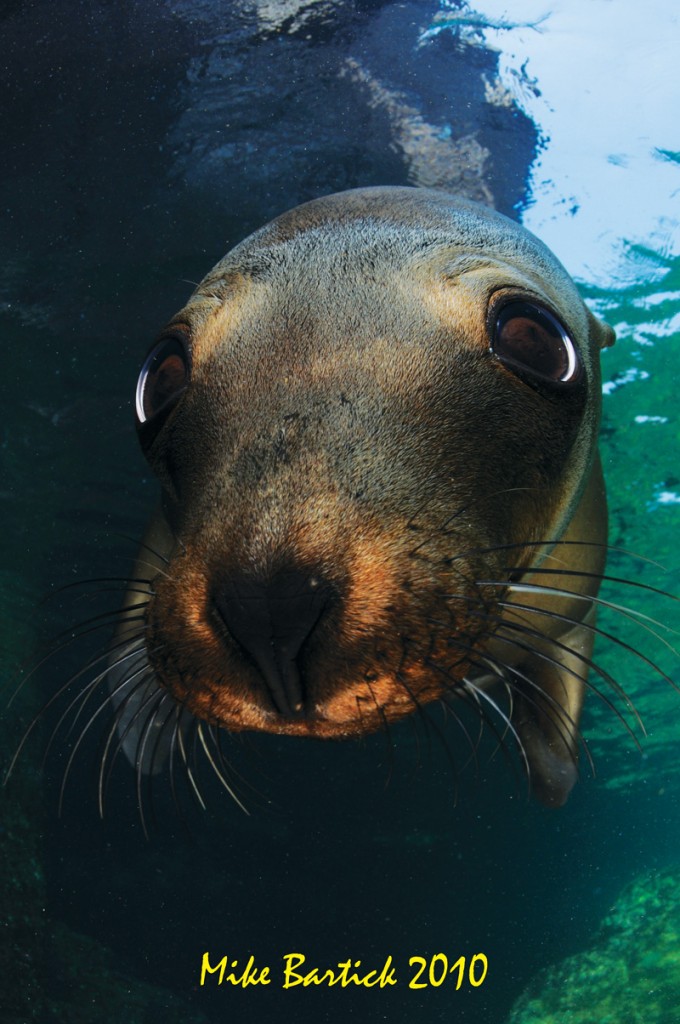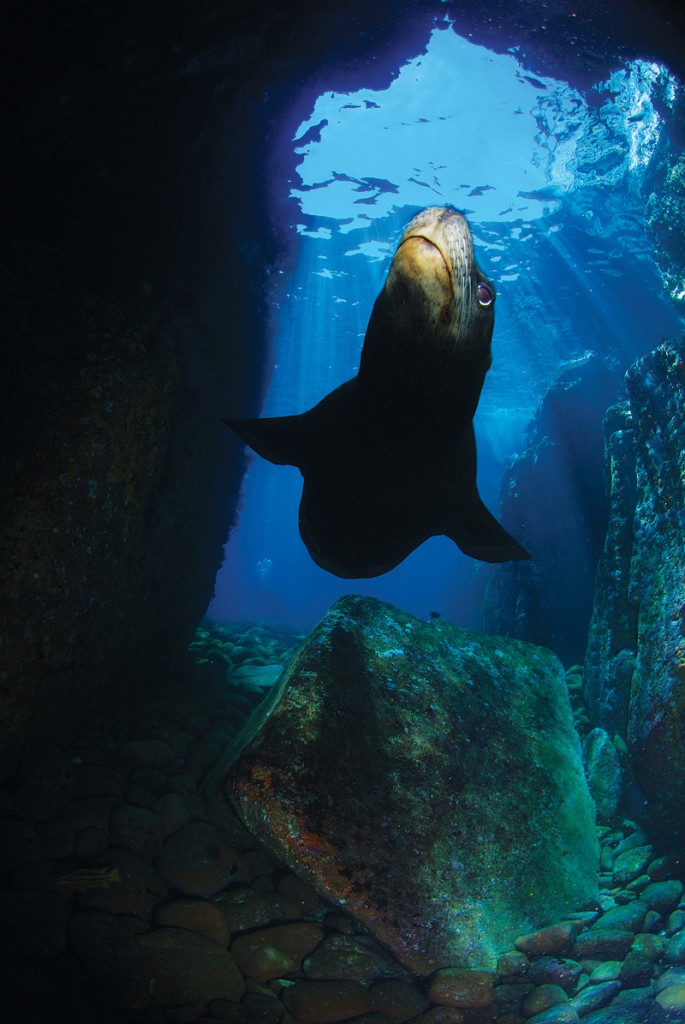One of my favorite things about
diving California is the opportunity
to interact with sea lions and harbor seals.
Inquisitive, playful and sometimes mischievous, these aquatic mammals are tons of fun.
The word Pinniped (Pinna meaning winged or fin and Ped meaning foot) is applied for good reason. Proportionally, their limbs are much smaller than those of most other mammals. Their fingers are webbed together, as are the toes, with skin tissue. This allows them to maneuver much easier in comparison to birds, which need a greater wingspan to support themselves. In the water, sea lions are weightless, which explains their crazy aquatic antics.
Sea lions and seals spend approximately two thirds of their adult life at sea hunting and feeding, and can be found all along the Pacific coastline, wherever the local food supply will support them. Males are generally much larger than the females, and may have up to 15 females in their harem.
Aggressively protecting the reproduction rookeries, the big males or bulls should never be approached. Sea lions mate approximately 20 – 30 days after the birth of their pup, leaving only about one month out of the entire year that she is not pregnant. After giving birth, the females teach their young to hunt, and they spend much of their days cavorting and socializing.
Words & Photos by Mike Bartick. Visit Mike’s website at saltwaterphoto.com
Sea lions can easily dive to depths well over 100 feet and breath hold up to two hours. Conserving oxygen by slowing the heart rate, arteries are squeezed and metabolism slows. However once they return to the surface a period of time is needed for recovery. Not unlike divers, withstanding great pressures at depth requires a rest period between dives.
In Southern California there are basically three areas for reliably diving with sea lions and other pinnipeds. Santa Barbara Island, San Miguel Island and Anacapa Island can all dish up incredible opportunities. San Miguel and Santa Barbara are both rookery sites where males will defend mating territories and specific females. Anacapa acts as a haul-out where the females will sometimes give birth to her pups, feed and sun themselves.
 For a quick day trip, I choose to head up to Ventura harbor and catch a ride one of my favorite socal boats, the Spectre. We motored out to a site on the Southeast end of Anacapa called Underwater Arch. Captain Ted uses an underwater car alarm to alert the playful sea lions that we have arrived, and as the captain says, “if they want to play they will approach”. Suddenly, the water erupts with what looks like hundreds of stampeding wiener dogs heading in our direction. Little pups and mommas scoot through the water in our direction, in anticipation of the first diver dropping in. In addition to sea lions, Anacapa also plays host to Harbor Seals which are also very playful, but tend to be more singular then social. They’re often found in pairs but rarely seen in packs.
For a quick day trip, I choose to head up to Ventura harbor and catch a ride one of my favorite socal boats, the Spectre. We motored out to a site on the Southeast end of Anacapa called Underwater Arch. Captain Ted uses an underwater car alarm to alert the playful sea lions that we have arrived, and as the captain says, “if they want to play they will approach”. Suddenly, the water erupts with what looks like hundreds of stampeding wiener dogs heading in our direction. Little pups and mommas scoot through the water in our direction, in anticipation of the first diver dropping in. In addition to sea lions, Anacapa also plays host to Harbor Seals which are also very playful, but tend to be more singular then social. They’re often found in pairs but rarely seen in packs.
Photographing these creatures is a seemingly simple task, and for the most part that is true. But there are a couple more skills that I would like to elaborate on to help change a Sea Lion’s picture into a beautiful photograph. In particular, patience and anticipation are two skills which will help with shooting photos of any animal land or sea, but with sea lions it can make a significant difference.
Patience in the water will allow the sea lions to relax and become comfortable with you, and when this happens, you will know by their change in behavior. When comfortable, sea lions will often park themselves face to mask with divers, grab a fin, and even tug on their leg. These are wonderful photo ops. harbor seals will sneak up and tug a fin too, but then shy away when turned towards. Resisting the temptation to chase them about for a photo will allow them to feel like they are in charge, and they’ll often return for more photo opportunities.
Then there’s the flyby, and these are often the toughest photos to capture. Waiting for just the right moment can require many attempts, often while fighting the urge to fire in the threat of missing the opportunity. Split second timing is everything when trying to get a great photo of this move. Indeed, catching a swiftly moving sea lion with stern eye contact is tough.
Anticipation is another skill that’s important while observing and photographing animals in their natural environment. By carefully watching any timid creature, they will reveal another side of their nature. Give it a few minutes, and you will learn to see swimming patterns or certain behavioral displays that will make for a very unique photo, and help you find the right time to click the shutter.
 For instance, while watching and observing one harbor seal I noticed it would tuck itself into the eel grass. I slowly approached, watching the eel grass sway back and forth in the gentle surge, and it appeared to me that the harbor seal was trying to take a nap. I anticipated the shot knowing the seal was going to be caught off guard. One shot is all you get for chances like this – be sure to be ready!
For instance, while watching and observing one harbor seal I noticed it would tuck itself into the eel grass. I slowly approached, watching the eel grass sway back and forth in the gentle surge, and it appeared to me that the harbor seal was trying to take a nap. I anticipated the shot knowing the seal was going to be caught off guard. One shot is all you get for chances like this – be sure to be ready!
SLR shooters will do best by using a fast shutter speed of at least 125 or faster, with F-stops set at 8. Compact shooters can also use the time value setting for this feature. It is important to use a fast shutter speed to stop the action, otherwise your photos will be soft. Remember, sea lions can move at speeds up to 25mph underwater – that’s very fast!
Getting close to your subject will also help with sharpness and colors. Let them come to you, patiently anticipate the next move and fire away.
It’s no secret in the hunting world that using a blind for discretion works, so why not apply the same idea for photographing seals and sea lions? Use rocks and kelp to hide and wait, and often the sea lions will actually play a little hide and seek game and tuck away, appear, pose and move on.
Diving with California sea lions are such an incredible perk added to the California dive experience and is so easily overlooked. Be sure to take full advantage this spring, as May kicks off the birthing season. Anacapa is an easy day trip to reliably experience diving with sea lions.
Have fun!
—————————————————
Words & Photos by Mike Bartick. Visit Mike’s website at saltwaterphoto.com.
